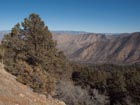
A mature tree in habitat [C.J. Earle, 2014.01.17].
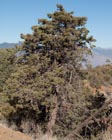
Mature tree; although only about 6 m tall, few trees are taller [C.J. Earle, 2014.01.17].
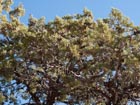
Crown, showing high density of retained cones of many ages [C.J. Earle, 2014.01.17].
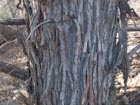
Bark on a tree about 30 cm diameter [C.J. Earle, 2014.01.17].
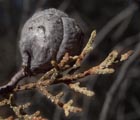
Mature seed cone and foliage [C.J. Earle, 2014.01.17].

Foliage and many pollen cones [C.J. Earle, 2014.01.17].

Foliage, twigs, first-year cones, and mature cone [C.J. Earle, 2014.01.17].
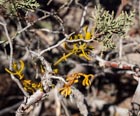
Mistletoe (Phoradendron sp.) on a tree in habitat [C.J. Earle, 2014.01.17].
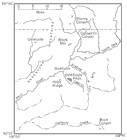
Distribution (Griffin and Critchfield 1972).

Burned forest and regeneration along roadway; stand burned 2 years earlier [C.J. Earle, 2014.01.17].
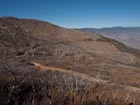
Most of the area burned in 2012. Unburned Cupressus forest visible on far side of burn [C.J. Earle, 2014.01.17].

Two burned snags. Some scorched foliage remains; all cones have opened and shed their seed [C.J. Earle, 2014.01.17].
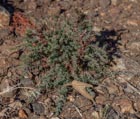
Seedling ca. 10 cm tall in burned area [C.J. Earle, 2014.01.17].

Seedling from the burned area [C.J. Earle, 2014.01.17].

Conservation Status

Hesperocyparis nevadensis
(Abrams) Bartel (2009)
Common names
Piute (Silba 1986) or Paiute (Peattie 1950) cypress.
Taxonomic notes
Synonymy: see POWO (accessed 2023.12.16). See Hesperocyparis arizonica for discussion of the relationship between various taxa assigned by some authors to H. arizonica. See Hesperocyparis for a discussion of the relationship between this and other, closely related Hesperocyparis taxa in northwest Mexico and the adjacent Southwest U.S.
Description
Trees to 10 m tall and 60-80 cm dbh with a straight trunk, slender when young, developing a deep pyramidal crown, branching stiffly and obtusely. Bark red-brown when young, sometimes exfoliating, with age becoming gray-brown, fibrous, 1-2 cm thick. Branchlets about 20 mm long, 1-1.5 mm thick, quadrangular. Foliage glaucous, faintly aromatic when crushed, leaves 2 mm long, acute, keeled with an abaxial resin gland that is conspicuous even on the youngest leaves. Leaf margins fimbriate-ciliate at 10X magnification. Occasionally, short-lived leaves 3-4 × 8-12 mm form. Pollen cones abundant, shedding pollen in February and March, cones 3-5 mm long, composed of (10-)12(-16) scales each bearing 5-6 pollen sacs. Seed cones 20-30 mm long, ovoid to globose, composed of 6-8 scales with pointed conical umbos, borne on a 2-3 × 10-15 mm peduncle, solitary on branchlet tips, usually in aggregations of 15-25 cones along 10-20 cm of a larger branch, brown in first year, maturing to silver-gray in the second year; serotinous, opening in hot weather or in response to fire; retained for many years, even after opened. Seeds light tan, to 5 mm long with a 0.5 × 2 mm hilum, echinate or slightly glaucous. Seedlings with 4-5 linear, flattened, blunt cotyledons 15 mm long (Wolf 1948 and pers. obs. 2014.01.17).
Distribution and Ecology
USA: California: Kern County: the drainage of Bodfish Creek, and, at 4000 feet, on Red Hill in the Paiute Mountains (Peattie 1950), where it grows at elevations of 5000-6000 feet with Juniperus californica, Pinus sabiniana, P. monophylla and Ephedra viridis (Abrams 1919), as well as Ceanothus cuneatus, Cercocarpus betuloides, and Arctostaphylos patula (BioHere 2008).
The species is highly fire-associated, with serotinous cones and a strong association with chaparral vegetation. The most extensive grove, the Bodfish Piute Cypress Grove Botanical Area (where all photos on this page were taken), covers 280 ha within which there was an 80 ha fire in 1921 and an earlier more extensive fire ca. 1976 (BioHere 2008). A more recent fire burned about 80 ha, probably in summer 2012 (based on analysis of Google Earth imagery for 2009 and 2013, and fragmentary newspaper accounts). Other, smaller groves also have a history of episodic fire. When I visited the site in early 2014 there was abundant regeneration, ranging from new seedlings a few centimeters tall to saplings nearly 2 m tall.
Remarkable Specimens
The largest on record has height 14 m, dbh 93 cm, crown spread 9 m; another has height 10 m, dbh 100 cm, crown spread 12 m; both grow in Sequoia National Forest, California (American Forests 2000).
Ethnobotany
"Like most of the native Cypresses, this one has long been used by the ranchers in the vicinity for fence posts, since it lasts for years in contact with the soil" (Peattie 1950).
Observations
Herbarium collections have been made in the following locales: 1) Piute Mountain Kernville Quad., Piute Mountain Elevation: 4500 ft; 2) Greenhorn Mountains at 3850 ft, about 5.8 mi E of and below the Greenhorn Summit Store along the Old Kernville Road, then about 0.2 mi to the right along a side road to a creek that heads below the store; 3) Greenhorn Mountains, Black Mt., 4200 ft, just about 5 mi below (E of) the Greenhorn Summit Store in a dry, rocky gully that slopes S from the rocky S side of Black Mt. along the Old Kernville Road; 4) 3000 ft in oak woodland near Bodfish at the base of Piute Mt.; 5) Piute Lookout, Piute Peak about 2.5 mi e of its junction along road from Havilat-Bodfish summit to Piute Mountains, Red Hill 5000 ft. The largest grove covers the north face of Bald Eagle Peak in Kern County, California (Lanner 1999). This area has been preserved as the Bodfish Piute Cypress Botanical Area; a map is HERE. To get there simply take the paved Caliente-Bodfish road south out of Bodfish for about 3 miles (4.8 km) to the pass. Here turn east on the dirt surface Saddle Springs Road. In about 2 miles (3.25 km) you enter the cypress grove, and thereafter the species is abundant until the road leaves the grove in about another 2.5 miles (4.0 km), except that about half of the grove was burned in 2012. When I was there in 2014 the road was passable in an ordinary passenger car, but a rainstorm could easily change that. There is room to park at the pass.
Remarks
The epithet nevadensis refers to the Sierra Nevada, where this species is native - albeit at the southernmost limit of the mountain range.
This cypress was discovered in 1907 by Mrs. Leo Polkinghorn, but it took until 1915 for Leroy Abrams to inspect specimens forwarded by Mrs. Polkinghorn and to visit the grove she described (Abrams 1919). "Leroy Abrams ... drove south along the road between Bodfish and Havilah for about 3 miles to the summit of a grade, then turned off on an unsurfaced clay road ... for 2 1/2 miles. And there he came upon thousands of specimens of this conical tree, its foliage in summer, when Abrams first saw it, a dusty gray-green, though in spring when the rains are ending it is a fine glowing green. Flowering takes place in February and March and at that time many of the specimens, according to the ranchers, appear as golden trees, powdered over with untold numbers of yellow male flowers" (Peattie 1950).
Citations
Abrams, L. R. 1919. A new California cypress. Torreya 19:92. http://www.cupressus.net/CUnevadensisAbrams.html, courtesy of the Cupressus Conservation Project website.
American Forests 2000. The National Register of Big Trees 2000. Washington, DC: American Forests.
Bartel 2009: described in Adams, R. P., J. A. Bartel and R. A. Price. 2009. A new genus, Hesperocyparis, for the cypresses of the western hemisphere. Phytologia 91(1):160-185.
BioHere. 2008. Bodfish Piute Cypress Grove Botanical Area And Vicinity. biohere.com/natural_areas/california/Kern_County/bodfish_piute_cypress_grove_bota.php, accessed 2014.01.25.
See also
The species account at Threatened Conifers of the World.
Farjon (2005) provides a detailed account, with illustrations.
Lanner (1999) provides illustrations and incidental information.
Sheehey, Alison. 2006. Bodfish Piute Cypress Botanical Area. http://natureali.org/SQF/cypress.html, accessed 2007.01.01, now defunct. Includes photos and information on how to access the trees at the site, which adjoins the Piute Cypress Research Natural Area.
Wuenschel, Amarina, Jim A. Bartel, and Alexis Bernal. 2023. Forty years of change in Piute cypress (Hesperocyparis nevadensis), a rare California tree, after frequent fire and drought. Aliso: A Journal of Systematic and Floristic Botany 41(1), Article 6.
Available: https://scholarship.claremont.edu/aliso/vol41/iss1/6.














